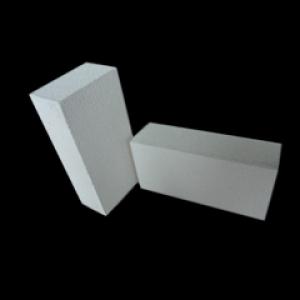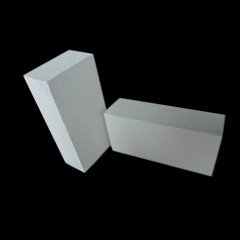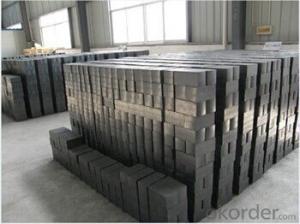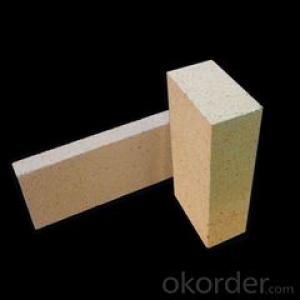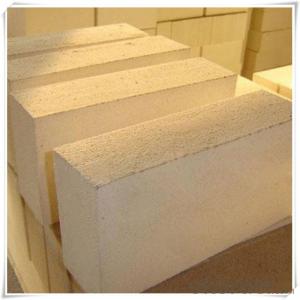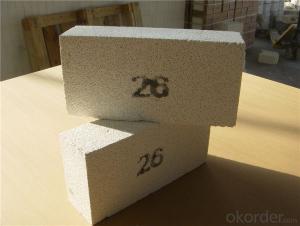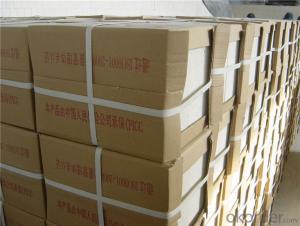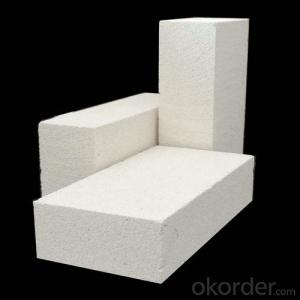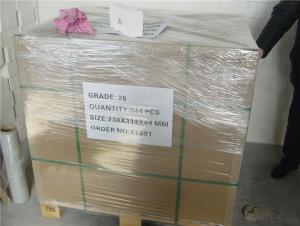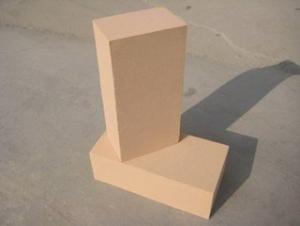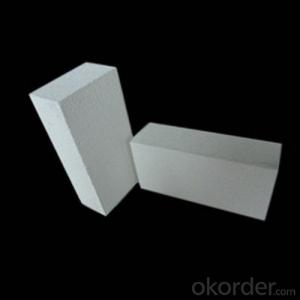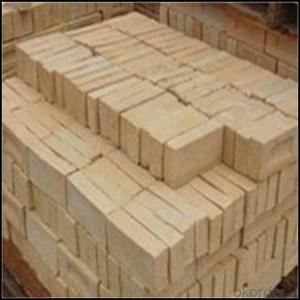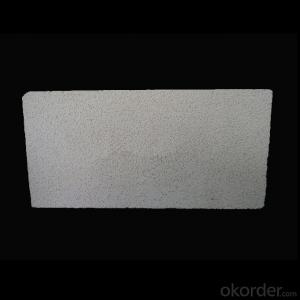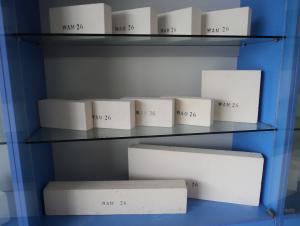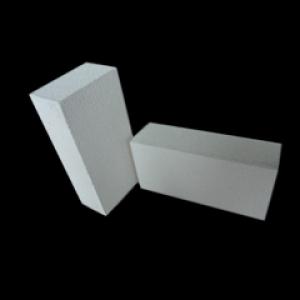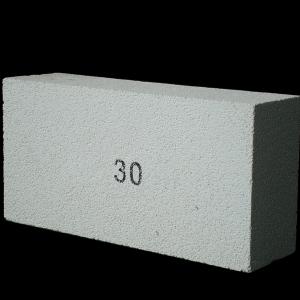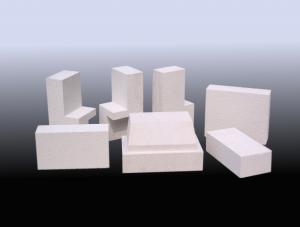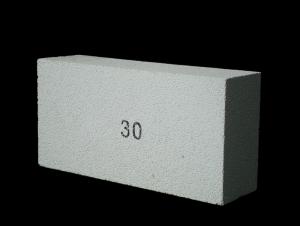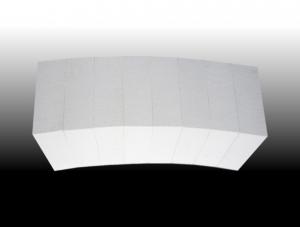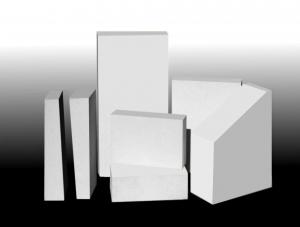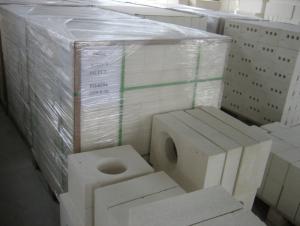High-Quality Insulating Fire Bricks
- Loading Port:
- China Main Port
- Payment Terms:
- TT OR LC
- Min Order Qty:
- -
- Supply Capability:
- 5000 m.t./month
OKorder Service Pledge
OKorder Financial Service
You Might Also Like
Product description:
lightweight mullite brick is made from high-grade and high purity refractory powders and materials.During the process of production,organic and multiple filling materials are injected according to required proportion.The brick is compressed in vacuum and sintered under high temperature. Category:
LYJM-23A LYJM-23B LYJM-23C
LYJM-26A LYJM-26B LYJM-26C
LYJM-28A LYJM-28B
LYJM-30A LYJM-30B
Features:
Low thermal conductivity and capacity
High purity,low content of impurity
High thermal resistance and could contact fire directly
High strength and resistant to thermal shock
Accurate measurement and incised optionally
Typical applications:
Lining and back lining of various furnaces in the industry of metallurgy,petrochemical,ceramics,machinery and building materials.
For instance:the Cracking Furnace,Conversion Furnace,heating equipment,refining equipment,Hot Blast Stove,Heating Furnace,Even-heating Furnace,Heat-processing Furnace,Resistance Furnace,Tunnel Kiln,Shuttle Kiln,Bell-cover Kiln,Glass-pool Kiln,etc
- Q: Are insulating fire bricks easy to clean?
- Yes, insulating fire bricks are relatively easy to clean. Due to their smooth and non-porous surface, they can be easily wiped down or scrubbed with water and mild detergent to remove any dirt or debris. However, it is important to avoid using harsh chemicals or abrasive materials that could damage the bricks.
- Q: Can insulating fire bricks be used in copper smelting furnaces?
- Yes, insulating fire bricks can be used in copper smelting furnaces. These bricks are designed to withstand high temperatures and provide excellent insulation, making them suitable for use in copper smelting processes where heat retention and efficiency are important.
- Q: Can insulating fire bricks be used in high-temperature kilns for pottery?
- Yes, insulating fire bricks can be used in high-temperature kilns for pottery. These bricks are specifically designed to withstand and retain heat, making them suitable for use in kilns that reach high temperatures. They help to insulate the kiln, preventing heat loss and allowing for more efficient firing of pottery.
- Q: Are insulating fire bricks suitable for use in oil refineries?
- Insulating fire bricks are generally not suitable for use in oil refineries. While insulating fire bricks are designed to withstand high temperatures, they are not resistant to the corrosive and abrasive nature of oil and its byproducts. Oil refineries involve a complex process of refining crude oil into various petroleum products, and this process often exposes the materials used in the refinery to harsh chemicals and high temperatures. Instead, oil refineries typically use refractory bricks or castables that are specifically designed to withstand the corrosive and abrasive conditions found in the refining process. Refractory materials used in oil refineries are resistant to chemical attack, have high strength and thermal shock resistance, and can withstand the extreme temperatures encountered during the refining process. Additionally, oil refineries require materials that can provide excellent insulation properties while also being durable and resistant to thermal stress. Insulating fire bricks, although they have good insulation properties, may not have the necessary durability and resistance to thermal stress required in the demanding environment of an oil refinery. Therefore, it is recommended to use refractory bricks or castables specifically designed for oil refineries, which can provide the necessary resistance to chemicals, high temperatures, and thermal stress, ensuring safe and efficient operation of the refinery.
- Q: Is the building built of cement hollow board safe?
- According to the use of building housing, before the use of cement hollow plate, it is necessary to predict the bearing capacity of housing, if more than the cement hollow plate bearing indicators, it is not available, it is unsafe;
- Q: How do insulating fire bricks help improve the efficiency of heat recovery systems?
- Insulating fire bricks play a crucial role in improving the efficiency of heat recovery systems in several ways. Firstly, these bricks are made from high-quality insulating materials such as ceramic fiber, which have excellent thermal properties. This means that they have a low thermal conductivity, preventing heat from escaping or being wasted. By using insulating fire bricks as lining materials in heat recovery systems, the heat exchange process becomes more efficient as less heat is lost to the surroundings. Secondly, insulating fire bricks help to reduce heat transfer through conduction. They act as a barrier between the hot and cold sides of the system, minimizing heat loss through direct contact. This insulation effect allows the heat recovery system to maintain a higher temperature on the hot side, maximizing the temperature difference and thus enhancing the heat transfer rate. Additionally, insulating fire bricks are lightweight and have low heat storage capabilities. This means that they require less energy to heat up and cool down, resulting in faster response times of the heat recovery system. This quick response enables the system to adapt rapidly to changes in heat generation or demand, improving its overall efficiency. Moreover, the use of insulating fire bricks as refractory materials in heat recovery systems helps to reduce energy consumption. Since these bricks can withstand high temperatures without cracking or deforming, they contribute to the longevity of the system, reducing the need for frequent repairs or replacements. This leads to lower maintenance costs and less downtime, ultimately improving the overall energy efficiency of the heat recovery system. In summary, insulating fire bricks enhance the efficiency of heat recovery systems by providing excellent thermal insulation, reducing heat loss through conduction, enabling quick response times, and minimizing energy consumption. Their use as lining materials significantly improves the heat transfer process, resulting in more effective heat recovery and utilization.
- Q: Are insulating fire bricks resistant to moisture absorption?
- Indeed, insulating fire bricks exhibit resistance to moisture absorption. These bricks have been meticulously engineered to possess a low porosity, thereby thwarting any moisture absorption. The manufacturing procedure entails the utilization of top-notch refractory materials that possess the capability to endure extreme temperatures, while simultaneously resisting the detrimental impact of moisture. Consequently, insulating fire bricks emerge as an exemplary option for scenarios necessitating moisture resistance, such as kilns, furnaces, and other environments characterized by elevated temperatures.
- Q: Can insulating fire bricks be used in the construction of thermal storage units?
- Insulating fire bricks are indeed capable of being utilized in the construction of thermal storage units. These bricks possess a specific design that grants them exceptional insulation properties, rendering them an optimal selection for thermal storage units. They are crafted from lightweight materials with low thermal conductivity, enabling them to retain heat for extended durations. Thermal storage units serve the purpose of storing and discharging heat energy as required. The inclusion of insulating fire bricks aids in minimizing heat loss from the stored energy, thus ensuring efficient and effective thermal storage. Their remarkable insulation properties facilitate superior heat retention, thereby diminishing the necessity for continuous heating or cooling. Furthermore, insulating fire bricks exhibit durability and can endure high temperatures, making them highly suitable for the construction of thermal storage units. They can withstand the thermal strains and temperature fluctuations that arise during the heating and cooling cycles of the unit, thereby guaranteeing its longevity and dependability. In conclusion, due to their outstanding insulation properties, durability, and ability to withstand high temperatures, insulating fire bricks are an appropriate and advantageous choice for the construction of thermal storage units.
- Q: Can insulating fire bricks be used in both residential and industrial applications?
- Yes, insulating fire bricks can be used in both residential and industrial applications. They are commonly used in residential fireplaces and wood-burning stoves for their insulating properties, as well as in industrial furnaces, kilns, and ovens to retain heat and improve energy efficiency.
- Q: Do insulating fire bricks require any special installation techniques?
- Yes, insulating fire bricks require special installation techniques. These bricks are typically lightweight and have low thermal conductivity, making them highly effective in insulating applications. To ensure proper installation, it is important to follow the manufacturer's guidelines and use appropriate tools, such as refractory mortar or adhesive, to securely bond the bricks together. Additionally, proper curing and drying procedures should be followed to avoid any potential cracking or damage during the installation process.
Send your message to us
High-Quality Insulating Fire Bricks
- Loading Port:
- China Main Port
- Payment Terms:
- TT OR LC
- Min Order Qty:
- -
- Supply Capability:
- 5000 m.t./month
OKorder Service Pledge
OKorder Financial Service
Similar products
Hot products
Hot Searches
Related keywords
